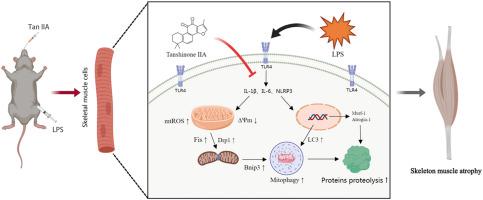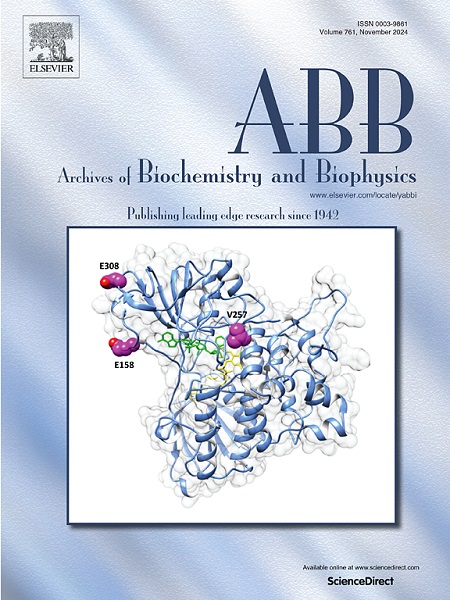Tanshinone IIA alleviates inflammation-induced skeletal muscle atrophy by regulating mitochondrial dysfunction
IF 3.8
3区 生物学
Q2 BIOCHEMISTRY & MOLECULAR BIOLOGY
引用次数: 0
Abstract
Skeletal muscle atrophy, characterized by loss of muscle mass and function, is often linked to systemic inflammation. Tanshinone IIA (Tan IIA), a major active constituent of Salvia miltiorrhiza, has anti-inflammatory and antioxidant properties. However, the effect of Tan IIA on inflammation-induced skeletal muscle atrophy remains unclear. Here, a mice model of the inflammatory muscle atrophy was established using lipopolysaccharide (LPS). Tan IIA intervention significantly increased muscle mass and strength, improved muscle fiber size, and maintained the integrity of skeletal muscle mitochondrial morphology in LPS-treated mice. Myotubes derived from myosatellite cells (MUSCs) were exposed to LPS in vitro. Tan IIA treatment inhibited LPS-induced muscle protein degradation and increased myotube diameter. Notably, Tan IIA attenuated LPS-induced inflammatory response and hyperactive mitophagy both in vivo and in vitro. In addition, Tan IIA treatment effectively diminished oxidative stress, inhibited the accumulation of mitochondrial reactive oxygen species (mtROS), and attenuated mitochondrial fission in LPS-treated myotubes. Reducing mtROS production helped to inhibit LPS-induced excessive mitophagy and myotubes atrophy. Together, our results reveal that Tan IIA can protect against inflammation-induced skeletal muscle atrophy by regulating mitochondrial dysfunction, presenting innovative potential therapeutics for skeletal muscle atrophy.

丹参酮 IIA 可通过调节线粒体功能障碍缓解炎症诱发的骨骼肌萎缩。
以肌肉质量和功能丧失为特征的骨骼肌萎缩通常与全身炎症有关。丹参酮 IIA(Tan IIA)是丹参的一种主要活性成分,具有抗炎和抗氧化特性。然而,丹参酮 IIA 对炎症诱导的骨骼肌萎缩的影响仍不清楚。本文利用脂多糖(LPS)建立了炎症性肌肉萎缩的小鼠模型。Tan IIA的干预能明显增加LPS处理小鼠的肌肉质量和力量,改善肌纤维大小,并保持骨骼肌线粒体形态的完整性。由肌卫星细胞(MUSCs)衍生的肌管在体外暴露于 LPS。Tan IIA 处理可抑制 LPS 诱导的肌肉蛋白降解,并增加肌管直径。值得注意的是,Tan IIA 在体内和体外均可减轻 LPS 诱导的炎症反应和过度活跃的有丝分裂。此外,Tan IIA 还能有效减轻氧化应激,抑制线粒体活性氧(mtROS)的积累,并减轻 LPS 处理肌管中线粒体的裂变。减少线粒体活性氧的产生有助于抑制 LPS 诱导的过度有丝分裂和肌管萎缩。总之,我们的研究结果揭示了 Tan IIA 可通过调节线粒体功能障碍来防止炎症诱导的骨骼肌萎缩,为治疗骨骼肌萎缩提供了创新的潜在疗法。
本文章由计算机程序翻译,如有差异,请以英文原文为准。
求助全文
约1分钟内获得全文
求助全文
来源期刊

Archives of biochemistry and biophysics
生物-生化与分子生物学
CiteScore
7.40
自引率
0.00%
发文量
245
审稿时长
26 days
期刊介绍:
Archives of Biochemistry and Biophysics publishes quality original articles and reviews in the developing areas of biochemistry and biophysics.
Research Areas Include:
• Enzyme and protein structure, function, regulation. Folding, turnover, and post-translational processing
• Biological oxidations, free radical reactions, redox signaling, oxygenases, P450 reactions
• Signal transduction, receptors, membrane transport, intracellular signals. Cellular and integrated metabolism.
文献相关原料
公司名称
产品信息
阿拉丁
Tan IIA
 求助内容:
求助内容: 应助结果提醒方式:
应助结果提醒方式:


